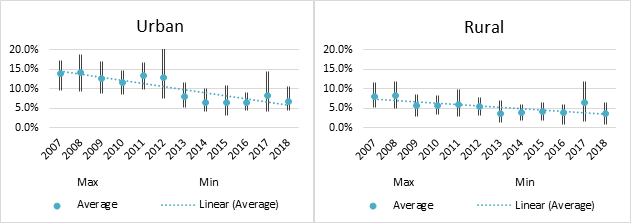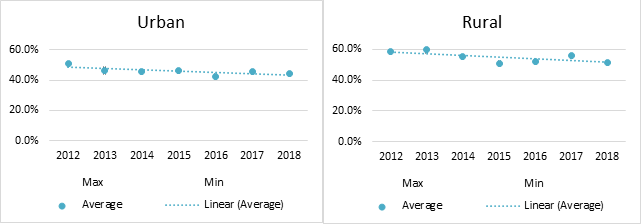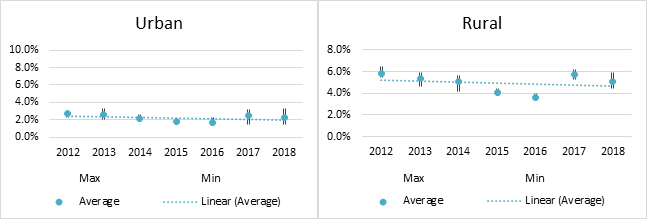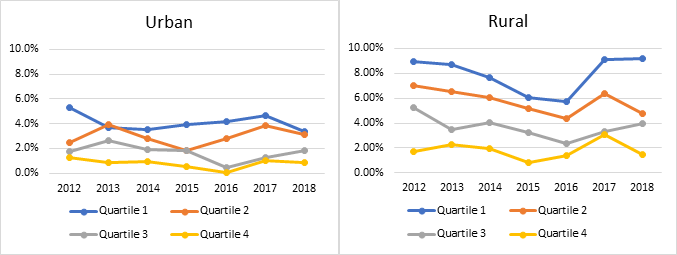 31
May
2023
31
May
2023
ISET Economist Blog
 Monday,
28
October,
2019
Monday,
28
October,
2019

 Monday,
28
October,
2019
Monday,
28
October,
2019
The Constitution of Georgia states “The State shall take care of human health care and social protection, ensuring the subsistence minimum and decent housing, and protecting the welfare of the family" (Constitution of Georgia, Article 5, 2017). However, at the moment, Georgian legislation is characterized by a lack of laws and regulations that clearly define the responsibilities of public institutions to solve housing-related issues in the country. To address this issue, the Government of Georgia (GoG) has established a working group including key stakeholders operating on social housing issues, led by top representatives of the Ministry of Internally Displaced Persons from the Occupied Territories, Labour, Health and Social Affairs of Georgia. The working group, which started its activity in the spring of 2019, is in charge of drafting a strategy to tackle the issue of unstable housing in the most efficient and effective way possible. ISET-PI joined the working group when it was established, supporting its activities through our economic and analytical expertise.
This blog intends to start a discussion about unstable housing in Georgia, based on ISET-PI’s preliminary analysis of the issue.
Unstable housing covers a wide range of circumstances, in which individuals or households cannot sufficiently control their residential environment. This lack of control is often represented by situations in which households experience involuntary residential moves and continue to be exposed to precarious housing conditions, such as being severely burdened by costs associated with housing or living in overcrowded or doubled-up housing.
According to the European Typology on Homelessness and Housing Exclusion (ETHOS) having a home is defined as a) having an adequate space over which a person and his/her family can exercise exclusive possession, b) being able to maintain privacy and enjoy relations, and c) having a legal title to occupation. Based on this definition, one can define four main categories of individuals/households facing the problem of unstable housing: roofless, homeless, people living insecurely, and people living in inadequate housing conditions (Table 1).
Table 1. European Typology on Homelessness and Housing Exclusion (ETHOS)1
| Conceptual Category | Operational Category | Living Situation |
| Roofless | People living rough | Public or external space |
| People staying in a night shelter | Night shelter | |
| Homeless | People in accommodation for the homeless | Homeless hostel |
| People in a women’s shelter | Women’s shelter accommodation | |
| People in accommodation for immigrants | Temporary accommodation/reception centers; Migrant worker accommodations | |
| People due to be released from institutions | Penal institutions; Medical institutions; Children’s institutions/homes | |
| People receiving longer-term support (due to homelessness) | Residential care for older homeless people; Supported accommodation for formerly homeless people. | |
| Insecure | People living in insecure accommodation | Temporarily with family/friends; No legal (sub)tenancy; Illegal occupation of land. |
| People living under the threat of eviction | Legal orders enforced (rented); Re-possession orders (owned) | |
| People living under the threat of violence | Police recorded indicators | |
| Inadequate | People living in temporary/non-conventional structures | Mobile home; Non-conventional building; Temporary structure. |
| People living in unfit housing | Occupied dwellings unfit for habitation | |
| People living in extreme overcrowding | Highest national norm of overcrowding. |
Source: ETHOS
As shown and reported in the existing literature, unstable housing can have adverse implications for the well-being of the individuals and households involved. Housing instability can negatively influence employment and job performance, physical and mental health, social relationships, subjective well-being, and children’s educational environments. Moreover, housing affordability issues (one of the key factors leading to unstable housing, together with housing availability) can adversely affect the savings behavior of society, leading to lower local investments (even in strategically attractive and profitable economic sectors) and higher foreign debt. Considering that both health and education outcomes define the level of human capital in a society, which — together with physical capital — affects economic performance, unstable housing is also likely to lead — through these channels — to lower socio-economic development.
Unstable housing also has other negative (non-strictly economic) effects as it hits the poorest and the richest groups in society asymmetrically, thereby undermining social cohesion and community bonds, increasing levels of crime and anti-social behavior, and ultimately deepening the issues of socio-economic inequality in the country.
Finally, unstable housing can also inhibit progress towards more environmentally sustainable dwellings, and greener society, with substantial negative impacts on the environment. For example, if affordability declines over time, the building and development industries — as well as households owning their own housing space — might become reluctant or unable to undertake the innovations needed for greater environmental sustainability, that might lead to an increase in prices and a reduction in demand (e.g. re-use of greywater, increased use of energy-rated building materials and appliances, more efficient use of insulation, better laid-out but more expensive estates that maximize orientation to the sun, greater use of quality multi-unit housing).
Quantifying unstable housing is challenging everywhere, as it is well-acknowledged by the relevant literature. Georgia is not an exception. The ISET-PI team has been working with the available data2, to conduct a preliminary analysis of the phenomenon of unstable housing in Georgia. Our preliminary findings show that the evolution of unstable housing during the last years has been characterized by encouraging trends, but also by concerning ones.
On the positive side, most indicators measuring unstable housing have been improving over time. For example, the share of households affected by housing unaffordability (classified as living in an unaffordable housing arrangement, the ratio [rent+utilities]/income must exceed 30%) has been clearly declining over time, from 14% to 6.7% in urban areas and from 8.1% to 3.6% in rural areas (Figure 1). This improvement has been possible thanks to the simultaneous increase in average wages and the relatively slow growth of housing-related costs.
Figure 1: Share of households exceeding the unaffordability threshold ((rent + expenditure)/income) in urban and rural areas

A declining trend can also be observed looking at the share of households claiming to be living in unfit houses (Figure 2). In this case, however, the picture is already less rosy. Despite the positive trend, in fact, the level of households living in unfit houses remains substantially high (44.3% of the households in urban areas, and 51.7% in rural areas in 2018).
Figure 2: Self-assessment of fitness status (need for capital renovation and/or at risk of collapse) of housing for urban and rural areas

An even more concerning picture emerges looking at the share of households claiming to live in a house at risk of collapse. As can be seen in Figure 3, in this case, the positive trend is much weaker, with a non-negligible—and relatively stable—share of households exposed to substantial risks (2.2% in urban areas and 5.1% in rural areas).
Figure 3: Self-assessment of houses at risk of collapse for urban and rural areas

Another lesson learned from our preliminary study is that the incidence of housing instability can differ dramatically for different subgroups of the population. For example, while most Georgians seem to have experienced an improvement in affordability of housing, the issue is still very relevant for the poorer part of the population, with about one out of seven urban households (and one out of ten rural households) belonging to the poorer 25% of the population spending more than 30% of their income on housing (Figure 4).
Figure 4: Share of households exceeding the unaffordability threshold ((rent+ expenditure)/income) in urban and rural areas

Looking at the fitness of housing, Figure 5 shows that the vulnerability of poor households (and especially their exposure to the risk of their house collapsing) is consistently higher than that of other parts of the population and, in rural areas, shows a worrying rebound during the last two years.
Figure 5. Self-assessment of houses at risk of collapse for urban and rural areas – by income quartile

Summarizing, what this preliminary analysis shows is that—despite the improvements over the past years—unstable housing remains a serious issue for a substantial portion of the Georgian population, particularly for the poorest households.
The roots of unstable housing are several, and many are associated with the existence of market failures (such as the presence of asymmetric information, external effects, or public good provision) and/or government failures (such as ineffective and inefficient regulatory framework) that will not be solved by themselves unless proper action is taken.
In this light, it is important for Georgia and its citizens that the challenge of unstable housing has now been recognized and accepted by the government, marking a new step towards the achievement of a more inclusive, prosperous, and sustainable society. As the quantity and quality of available data increases, the analysis will become sharper and more useful to policy-makers, helping to define the extent of the problem of unstable housing in the country, understand its roots, and devise the best strategy to tackle it.
1 According to ETHOS, a short stay is defined as less than a year, and a long stay is defined as more than one year.
2 The main sources of information available at this stage are municipalities, different institutions who have interests in the given field, shelters for children, women, elderly people, victims from violence and natural disasters; Ministry of Justice, its legal entity under public law National Bureau of Enforcement, Ministry of Economics and Sustainable Development, its legal entity under public law National Agency of State Property, Ministry of Internal Affairs, 112 and state funds like Atipund. ISET-PI researchers have also been utilizing data from the Georgia Household Survey Database assembled and distributed by the National Statistics Office of Georgia (Geostat).





